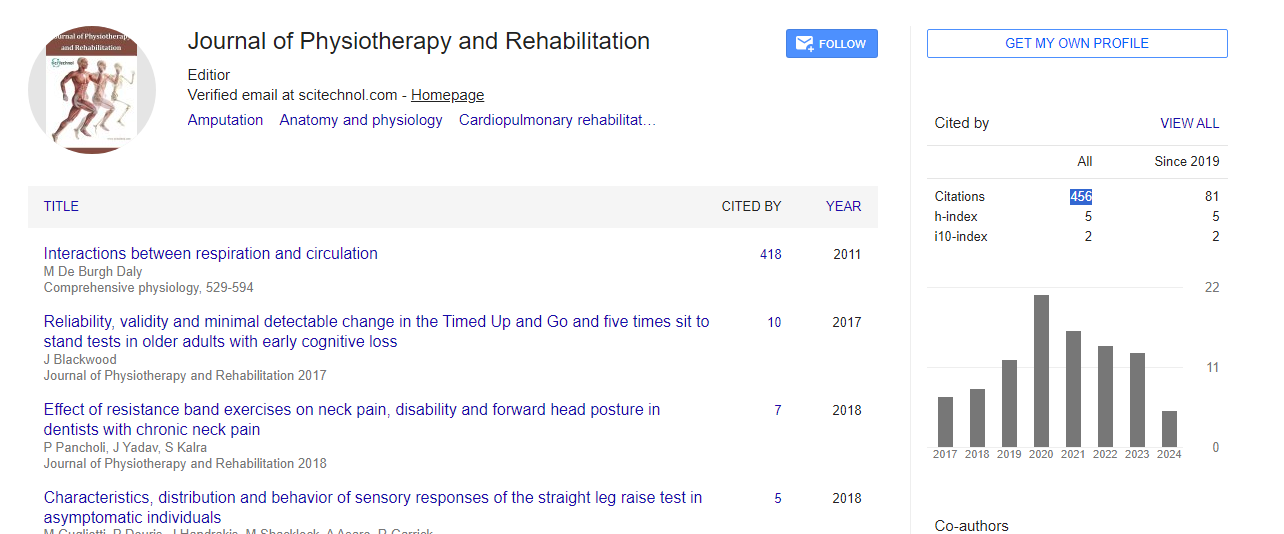Opinion Article, J Physiother Rehabi Vol: 8 Issue: 6
Kinesiology in Creating Customized Rehabilitation Plans for Stroke Survivors to Maximize Physical Recovery
Roser Young*
1Department of Kinesiology, Beijing Sport University, Beijing, China
*Corresponding Author: Roser Young,
Department of Kinesiology, Beijing Sport
University, Beijing, China
E-mail: youngrose@r.edu.cn
Received date: 23 November, 2024, Manuscript No. JPTR-24-155486;
Editor assigned date: 25 November, 2024, PreQC No. JPTR-24-155486 (PQ);
Reviewed date: 09 December, 2024, QC No. JPTR-24-155486;
Revised date: 17 December, 2024, Manuscript No. JPTR-24-155486 (R);
Published date: 24 December, 2024, DOI: 10.4172/JPTR.1000197.
Citation: Young R (2024) Kinesiology in Creating Customized Rehabilitation Plans for Stroke Survivors to Maximize Physical Recovery. J Physiother Rehabi 8:6.
Description
Kinesiology plays an essential role in the rehabilitation of stroke survivors, offering specialized techniques and approaches that are essential for maximizing physical recovery. A stroke can cause significant impairments, including motor and sensory deficits, cognitive difficulties and emotional challenges, all of which affect an individual’s ability to perform daily activities. Kinesiologists, with their deep understanding of human movement, biomechanics and exercise physiology, are instrumental in developing customized rehabilitation plans that address these challenges and help stroke survivors recover their independence, mobility and overall quality of life. After a stroke, individuals often experience a variety of motor impairments such as muscle weakness, spasticity and difficulty with coordination. These issues can severely limit the ability to perform basic activities of daily living, such as dressing, walking or eating. One of the primary goals of kinesiology in stroke rehabilitation is to restore movement patterns, improve strength and reestablish functional independence. A kinesiology-based rehabilitation plan typically starts with a thorough assessment of the individual's physical abilities, limitations and goals.
Strength training is often an essential component of stroke rehabilitation, as many survivors experience muscle weakness and atrophy due to immobility or paralysis. Kinesiologists work closely with patients to implement strength-building exercises that target both the upper and lower limbs, focusing on functional movements those real-life tasks. Resistance training, such as using weight machines, free weights or resistance bands, is often incorporated to enhance muscle strength. These exercises help rebuild muscle mass, improve joint stability and promote overall mobility, enabling survivors to recover their ability to move and perform everyday tasks more easily.
In addition to strength training, kinesiologists place a strong emphasis on improving balance and coordination in stroke survivors. Kinesiologists use a variety of therapeutic exercises to improve these aspects, including balance drills, functional movement training and postural control exercises. These exercises are designed to restore the body’s ability to maintain stability, reduce the risk of falls and promote safer movement patterns. Techniques such as standing on one leg, walking on uneven surfaces or using balance boards can help rebuild confidence and stability in survivors, empowering them to move more freely and safely. In addition to physical exercises, kinesiology-based rehabilitation plans often incorporate techniques to address sensory deficits that can arise after a stroke. Sensory impairments, such as loss of sensation in a limb or visual neglect, can interfere with movement and function. Kinesiologists may integrate sensory-motor activities into rehabilitation, such as tactile stimulation, joint mobilizations or visual tracking exercises, to help restore sensory awareness and improve motor control. By improving the body’s ability to sense and respond to external stimuli, these techniques can enhance both the safety and effectiveness of movement.
Psychological health is also an important consideration in the rehabilitation process, as many stroke survivors experience emotional distress, depression or anxiety due to the physical and cognitive changes they face. Kinesiologists recognize the mind-body connection and often work in conjunction with other healthcare professionals, such as psychologists or occupational therapists, to address the emotional challenges of stroke recovery. Exercise, in particular, has been shown to have a positive impact on mood and mental health.
Conclusion
Kinesiology offers invaluable tools and techniques for creating customized rehabilitation plans that help stroke survivors maximize their physical recovery. By focusing on strength, balance, coordination, gait and sensory restoration, kinesiologists develop individualized interventions that address the unique needs of each patient. With their expertise in human movement and exercise science, kinesiologists play an essential role in helping stroke survivors regain their independence, improve their mobility and enhance their quality of life. Through ongoing support, motivation and personalized rehabilitation programs, kinesiology empowers stroke survivors to achieve their physical recovery goals and lead fuller, more active lives.
 Spanish
Spanish  Chinese
Chinese  Russian
Russian  German
German  French
French  Japanese
Japanese  Portuguese
Portuguese  Hindi
Hindi 